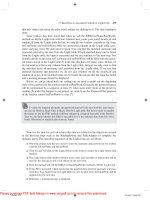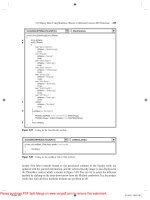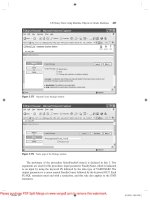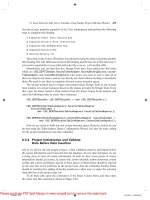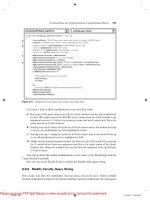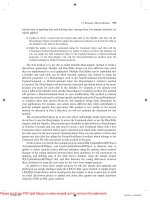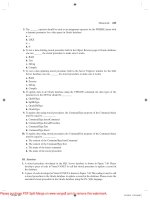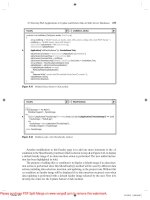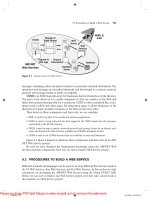Practical Database Programming With Visual C#.NET- P9
Bạn đang xem bản rút gọn của tài liệu. Xem và tải ngay bản đầy đủ của tài liệu tại đây (1011.53 KB, 50 trang )
5.20 Query Data Using Runtime Objects to Oracle Database
423
The prototype of the procedure SelectFacultyCourse() is declared in line 3. Two
arguments are used for this procedure: input parameter FacultyName, which is indicated
as an input by using the keyword IN followed by the data type of VARCHAR2. The
output parameter is a cursor named FacultyCourse followed by the keyword OUT. Each
PL - SQL statement must end with a semicolon, and this rule also applies to the END
statement.
Figure 5.175
Opened Create Package window.
Figure 5.176
Name page of the Package window.
c05.indd 423c05.indd 423 2/11/2010 2:59:14 PM2/11/2010 2:59:14 PM
Please purchase PDF Split-Merge on www.verypdf.com to remove this watermark.
424
Chapter 5 Data Selection Query with Visual C#.NET
Click on the Finish button to complete this step. You can click on the Compile button
to compile this specifi cation block if you like. Next we need to create the body block of
this package. Click on the Body tab to open the Body page, which is shown in Figure
5.179 .
Click on the Edit button to begin to create our body part. Enter the PL - SQL codes
into this body shown in Figure 5.180 .
The procedure prototype is redeclared in line 2. But an IS operator is attached at the
end of this prototype and it is used to replace the AS operator to indicate that this proce-
Figure 5.177
Opened Specifi cation page.
Figure 5.178
Coding for the Specifi cation page.
c05.indd 424c05.indd 424 2/11/2010 2:59:18 PM2/11/2010 2:59:18 PM
Please purchase PDF Split-Merge on www.verypdf.com to remove this watermark.
5.20 Query Data Using Runtime Objects to Oracle Database
425
dure needs to use a local variable facultyId, and this variable will work as an intermediate
variable to hold the returned faculty_id from the fi rst query, which is located at line 6.
Starting from BEGIN, our real SQL statements are included in lines 6 and 7. The
fi rst query is to get the faculty_id from the Faculty table based on the input parameter
FacultyName, which is the fi rst argument of this procedure. A SELECT … INTO state-
ment is utilized to temporarily store the returned faculty_id into the intermediate variable
facultyId.
Figure 5.179
Opened Body page of the package.
Figure 5.180
Coding for the Body part of the package.
c05.indd 425c05.indd 425 2/11/2010 2:59:21 PM2/11/2010 2:59:21 PM
Please purchase PDF Split-Merge on www.verypdf.com to remove this watermark.
426
Chapter 5 Data Selection Query with Visual C#.NET
The OPEN FacultyCourse FOR command is used to assign the returned data columns
from the following query to the cursor variable FacultyCourse. Recall that we used a SET
command to perform this assignment functionality in the SQL Server stored procedure
in Section 5.19.2.7.4 . Starting from lines 9 and 10, the second query is declared, and it is
to get all course_id and courses taught by the selected faculty from the Course table based
on the intermediate variable ’ s value, faculty_id, which is obtained from the fi rst query
above. The queried results are assigned to the cursor variable FacultyCourse.
Now let ’ s compile our package by clicking on the Compile button. A successful
compiling information
PL/SQL code successfully compiled (22:20:06)
will be displayed if this package is bug free, which is shown in Figure 5.181 .
The development of our Oracle package is complete, and now let ’ s go to the Visual
Studio.NET to call this package to perform our course query for our Course form.
5.20.3.9 Query Data Using Oracle Package for Course Form
Open the Course form window and double - click on the Select button to open its Click
method and enter the codes shown in Figure 5.182 into this method.
Let ’ s take a look at this piece of code to see how it works.
A. The package query string is declared, and this string contains both the package ’ s name
(Faculty_Course) and the stored procedure ’ s name (Select FacultyCourse). All query
strings for the Oracle database package must follow this style. The package ’ s name and
the procedure ’ s name defi ned in this string must be identical with those names we used
when we created this package in the Object Browser in Oracle Database 10g XE. Otherwise
your calling to this package would fail.
Figure 5.181
Compiled coding for the body part of the package.
c05.indd 426c05.indd 426 2/11/2010 2:59:26 PM2/11/2010 2:59:26 PM
Please purchase PDF Split-Merge on www.verypdf.com to remove this watermark.
5.20 Query Data Using Runtime Objects to Oracle Database
427
private void cmdSelect_Click(object sender, EventArgs e)
{
string cmdString = "Faculty_Course.SelectFacultyCourse";
OracleParameter paramFacultyName = new OracleParameter();
OracleParameter paramFacultyCourse = new OracleParameter();
OracleDataAdapter CourseDataAdapter = new OracleDataAdapter();
OracleCommand oraCommand = new OracleCommand();
DataTable oraDataTable = new DataTable();
OracleDataReader oraDataReader;
LogInForm logForm = new LogInForm();
logForm = logForm.getLogInForm();
paramFacultyName.ParameterName = "FacultyName";
paramFacultyName.OracleType = OracleType.VarChar;
paramFacultyName.Value = ComboName.Text;
paramFacultyCourse.ParameterName = "FacultyCourse";
paramFacultyCourse.OracleType = OracleType.Cursor;
paramFacultyCourse.Direction = ParameterDirection.Output;
oraCommand.Connection = logForm.oraConnection;
oraCommand.CommandType = CommandType.StoredProcedure;
oraCommand.CommandText = cmdString;
oraCommand.Parameters.Add(paramFacultyName);
oraCommand.Parameters.Add(paramFacultyCourse);
if (ComboMethod.Text == "DataAdapter Method")
{
CourseDataAdapter.SelectCommand = oraCommand;
CourseDataAdapter.Fill(oraDataTable);
if (oraDataTable.Rows.Count > 0)
FillCourseTable(oraDataTable);
else
MessageBox.Show("No matched course found!");
oraDataTable.Dispose();
CourseDataAdapter.Dispose();
}
else if (ComboMethod.Text == "DataReader Method"
)
{
oraDataReader = oraCommand.ExecuteReader();
if (oraDataReader.HasRows == true)
FillCourseReader(oraDataReader);
else
MessageBox.Show("No matched course found!");
oraDataReader.Close();
}
else //LINQ to DataSe
t Method is selected...
{
CourseDataAdapter.SelectCommand = oraCommand;
CourseDataAdapter.Fill(ds, "Course");
var courseinfo = (from ci in ds.Tables["Course"].AsEnumerable()
select ci);
CourseList.Items.Clear();
foreach (var cRow in courseinfo)
{
CourseList.Items.Add(cRow.Field<string>("course_id"));
}
ds.Clear();
}
CourseList.SelectedIndex = 0;
}
A
B
C
D
E
F
G
H
I
J
K
L
M
N
O
P
Q
OracleSelectRTObject.CourseForm cmdSelect_Click()
Figure 5.182
Coding for the Select button Click method.
c05.indd 427c05.indd 427 2/11/2010 2:59:27 PM2/11/2010 2:59:27 PM
Please purchase PDF Split-Merge on www.verypdf.com to remove this watermark.
428
Chapter 5 Data Selection Query with Visual C#.NET
B. All data components used to perform this query are declared and created here. First, two
Oracle Parameter objects are created: paramFacultyName and paramFacultyCourse.
These two Parameter objects will be passed into the calling package, and they work as
input and output parameters, respectively. Some other components, such as the
DataAdapter, Command, DataTable, and Data Reader, are also created here.
C. T h e fi rst Parameter object is initialized here. Both parameter name, FacultyName, and the
data type, VARCHAR, must be identical with the name and the data type we used when
we created this procedure in Oracle Database 10g XE R2. The parameter ’ s value should
be equal to the selected name from the faculty name combobox (ComboName.Text) in
the Course form window in Visual C#.NET.
D. The second parameter is also initialized with the associated parameter name and data type.
One important point is that the second parameter is an output parameter and its data type
is cursor, and the transmission direction of this parameter is output. So the Direction
property of this Parameter object must be clearly indicated by assigning the Output to it.
Otherwise, the procedure calling may encounter some error and this error is hard to debug.
E. The Command object is initialized by assigning the associated property, such as
the Connection, CommandType, and CommandText. The CommandType must be
StoredProcedure and the CommandText should be the query string we declared at the
beginning of this method (step A ).
F. Two initialized Parameter objects are added into the Command object, that is, they are
added into the Parameters collection property of the Command object.
G. If the user selected the DataAdapter method, the initialized Command object is assigned
to the SelectCommand property of the DataAdapter, and the Fill() method is executed to
fi ll the Course table. Basically, only at this moment, the Oracle package we developed is
called and two queries are executed. The returned columns should be stored in the Course
data table if this fi ll is successful.
H. If the Count property of the Course table is greater than 0, which means that at least one
row is fi lled into the table, the user - defi ned method FillCourseTable() is called to fi ll the
queried course_id into the CourseList box in the Course form window. Otherwise, an error
message is displayed to indicate that this fi ll has failed.
I. Some cleaning jobs are performed to release some data objects used for this query.
J. If the user selected the DataReader method, the ExecuteReader() method is executed to
invoke the DataReader to retrieve required columns and store the returned results into the
DataReader. If the property HasRows is true, which means that DataReader did read back
some rows, the user - defi ned method FillCourseReader() is called to fi ll the CourseList box
in the Course form window with the read rows. Otherwise, an error message is displayed.
K. Another cleaning job is performed to release the DataReader used for this query.
L. If the user selected the LINQ to DataSet method, the initialized Command object is
assigned to the SelectCommand property of the DataAdapter, and the Fill() method is
executed to initialize the DataSet with the stored procedure. This operation will not only
fi ll the Course table but also the Faculty table since there are two query operations in the
package we built above.
M. A typical LINQ query structure is created and executed to retrieve back all course_id from
the Course table. The courseinfo is a Visual C# 2008 implicitly typed local variable with a
data type var. The Visual C# 2008 will be able to automatically convert this var to any
suitable data type. In this case, it is a collection, when it sees it. An iteration variable ci is
used to iterate over the result of this query from the Course table. Then a similar SQL
c05.indd 428c05.indd 428 2/11/2010 2:59:27 PM2/11/2010 2:59:27 PM
Please purchase PDF Split-Merge on www.verypdf.com to remove this watermark.
5.20 Query Data Using Runtime Objects to Oracle Database
429
SELECT statement is executed without the WHERE clause. The reason for that is because
we have built the Command object oraCommand by assigning both the input and output
parameters to the Parameters collection. Therefore, we do not need to use any other query
criterion here. Another key point for this structure is the operator AsEnumerable(). Since
different database systems use different collections and query operators, those collections
must be converted to a type of IEnumerable < T > in order to use the LINQ technique
because all data operations in LINQ use Standard Query Operators that can perform
complex data queries on an IEnumerable < T > sequence. A compiling error would be
encountered without this operator.
N. The CourseList box is cleaned up to make it ready to add and display all course_id for
the selected faculty. This code is important and necessary. Without this line, duplicated
course_id will be added and displayed in this CourseList box.
O. A foreach loop is utilized to pick up each course_id from the selected result cRow, which
is obtained from the courseinfo we get from the LINQ query. Then, add each course_id
into the CourseList box in the CourseForm window to display them. Since we are using a
nontyped DataSet, we must indicate the column clearly with the fi eld < string > and the
column ’ s name as the position for each of them.
P. The DataSet is cleaned up after this query. This operation is important and necessary.
Without this line, multiple duplicated course_ids would be added and displayed in the
CourseList box since multiple duplicated query results are fi lled into the DataSet, that is,
into the Course table.
Q. This statement is very important and it is used to select the fi rst course_id in the CourseList
box as the default course as the Course form is opened. More important, this command
can work as a trigger event to trigger the CourseList box ’ s SelectedIndexChanged method
to display the detailed information related to that default course_id. The coding for that
method is our next job.
The coding for the FillCourseTable() and the Back button Click method have nothing
to do with any object used in this project. Thus, no coding modifi cation is needed. The
user - defi ned method FillCourseReader() needs only one small modifi cation, which is to
change the nominal argument ’ s type to OracleDataReader since now we are using an
Oracle data provider. The detailed explanations for methods FillCourseTable() and
FillCourseReader() can be found in Figure 5.92 . For your convenience, we list this piece
of code with some explanations again, which is shown in Figure 5.183 .
Let ’ s see how this piece of code works.
A. Before we can fi ll the CourseList box, a cleaning job is needed. This cleaning is very
important. Otherwise multiple repeat course_ids would be added and displayed in this
listbox if you forget to clean it up fi rst.
B. A foreach loop is used to scan all rows of the fi lled Course table. Recall that we fi lled 6
columns of data from the Course table in the database to this Course table in the DataTable
object, starting with the fi rst column — course_id — and the second column — course. Now
we need to pick up the fi rst column — course_id (column index = 0) — for each returned
row or record of the Course table. Then the Add() method of the ListBox control is used
to add each retrieved course_id into the CourseList box.
C. For the FillCourseReader() method, the data type of the passed argument is Oracle
DataReader since we are using an Oracle database as our data source.
D. A local string variable strCourse is created, and this variable can be considered as an
intermediate variable used to temporarily hold the queried data from the Course table.
c05.indd 429c05.indd 429 2/11/2010 2:59:28 PM2/11/2010 2:59:28 PM
Please purchase PDF Split-Merge on www.verypdf.com to remove this watermark.
430
Chapter 5 Data Selection Query with Visual C#.NET
E. Similarly, we need to clean up the CourseList box before it can be fi lled.
F. A while loop is utilized to retrieve each fi rst column ’ s data [GetString(0)] whose column
index is 0 and the data value is the course_id. The queried data fi rst is assigned to the
intermediate variable strCourse, and then it is added into the CourseList box by using the
Add() method.
Next we need to take care of the coding for the CourseList_SelectedIndexChanged()
method. The functionality of the coding for this method is to display the detailed course
information, such as the course title, course credit, classroom, course schedule, and enroll-
ment, for the selected course_id by the user when the user clicks on a course_id from the
CourseList box. Five textbox controls in the Course form are used to store and display
the detailed course information.
Now let ’ s begin to do our coding for this method. Open the Course form window and
double - click on the CourseList box (any place inside that list box) to open this method.
Enter the codes shown in Figure 5.184 into this method. Only the DataAdapter query
method is used for this method. Let ’ s take a look at this piece of code and see how it works.
A. The query string is fi rst declared, and we need to retrieve six columns from the Course
table. In fact, we have already gotten the course_id from the last query in the Select button
method. However, in order to keep the code neat, we still retrieve this column from this
query. A nominal parameter courseid that works as a dynamic parameter is assigned to
the course_id column as our query criterion. You need to note that the assignment opera-
tor for the dynamic parameter in Oracle is an equal operator plus a colon.
B. All data components used to perform this query are declared here, such as the DataAdapter,
Command object, and the DataTable objects. The keyword Oracle needs to be prefi xed
before these objects since we are using the Oracle data components to perform this query.
The new instance of the LogInForm class is used to allow us to access and use the global
connection object defi ned in that class.
C. The Command object is initialized by assigning it with associated properties such as the
Connection, CommandType, and CommandText.
private void FillCourseTable(DataTable CourseTable)
{
CourseList.Items.Clear();
foreach (DataRow row in CourseTable.Rows)
{
CourseList.Items.Add(row[0]); //the 1st column is course_id - cmdString
}
}
private void FillCourseReader(OracleDataReader CourseReader)
{
string strCourse = string.Empty;
CourseList.Items.Clear();
while (CourseReader.Read())
{
strCourse = CourseReader.GetString(0); //the 1st column is course_id
CourseList.Items.Add(strCourse);
}
}
A
B
C
D
E
F
OracleSelectRTObject.CourseForm FillCourseTable()
Figure 5.183
Coding for the FillCourseTable and FillCourseReader methods.
c05.indd 430c05.indd 430 2/11/2010 2:59:28 PM2/11/2010 2:59:28 PM
Please purchase PDF Split-Merge on www.verypdf.com to remove this watermark.
5.20 Query Data Using Runtime Objects to Oracle Database
431
D. The dynamic parameter courseid is added into the Parameters collection, which is a prop-
erty of the Command object using the Add() method. The real value of this parameter is
the course_id that is selected by the user from the CourseList box.
E. The SelectCommand property of the DataAdapter is assigned with the initialized
Command object, and the Fill() method is executed to fi ll the course table.
F. If the Count property of the returned data table is greater than 0, which means that at
least one row is fi lled into the table, the FillCourseTextBox() method is called to fi ll fi ve
textbox controls with retrieved six columns. Otherwise, an error message is displayed if
this fi ll has failed.
G. Some cleaning job is performed here to release all objects used for this fi ll table
operation.
Two user - defi ned methods, FillCourseTextBox() and MapCourseTable(), have no
relationship with any object used in this project. Therefore, no coding modifi cation is
needed for them. For the detailed line - by - line explanations of these two methods, refer
to Figure 5.94 in section 5.18.4 .
The coding for the Back button Click method is easy. Open this method and enter
this.Hide(); into this method. That ’ s all!
Before we can run the project to test our codes, we need to copy all faculty image
fi les to the folder in which our Visual C# executable fi le is located. In this application, it
is the Debug folder of the project. In our case, this folder is located at C:\Book 6\Chapter
5\OracleSelectRTObject\bin\Debug.
Now let ’ s start this project to test the codes we developed for the Course form. Click
on the Debug| Start Debugging button to run the project. Enter the suitable username and
password, such as jhenry and test for the LogIn form, and then select the Course Information
item from the Selection form window to open the Course form. Select the desired faculty
private void CourseList_SelectedIndexChanged(object sender, EventArgs e)
{
string cmdString = "SELECT course, credit, classroom, schedule, enrollment, course_id FROM Course ";
cmdString += "WHERE course_id =:courseid";
OracleDataAdapter CourseDataAdapter = new OracleDataAdapter();
OracleCommand oraCommand = new OracleCommand();
DataTable oraDataTable = new DataTable();
LogInForm logForm = new LogInForm();
logForm = logForm.getLogInForm();
oraCommand.Connection = logForm.oraConnection;
oraCommand.CommandType = CommandType.Text;
oraCommand.CommandText = cmdString;
oraCommand.Parameters.Add("courseid", OracleType.Char).Value = CourseList.SelectedItem;
CourseDataAdapter.SelectCommand = oraCommand;
CourseDataAdapter.Fill(oraDataTable);
if (oraDataTable.Rows.Count > 0)
FillCourseTextBox(oraDataTable);
else
MessageBox.Show("No matched course information found!");
oraDataTable.Dispose();
oraCommand.Dispose();
CourseDataAdapter.Dispose();
}
A
B
C
D
E
F
G
OracleSelectRTObject.CourseForm CourseList_SelectedIndexChanged()
Figure 5.184
Coding for the SelectedIndexChanged method.
c05.indd 431c05.indd 431 2/11/2010 2:59:28 PM2/11/2010 2:59:28 PM
Please purchase PDF Split-Merge on www.verypdf.com to remove this watermark.
432
Chapter 5 Data Selection Query with Visual C#.NET
name from the Faculty Name combobox and click on the Select button to list all courses
taught by this faculty in the CourseList box. Then click each course_id item from the
CourseList box, and the detailed course information related to the selected course_id will
be displayed in fi ve textbox controls in this form, which is shown in Figure 5.185 .
You can try to perform this query by using different methods with different faculty
members. Our coding is successful!
At this point we fi nished all coding for this project. As for the coding for the Student
form, we prefer to leave this job to students as their homework. A complete project
named XEOracleSelectRTObject can be found in the folder DBProjects\Chapter 5 that
is located at the accompanying ftp site (see Chapter 1 ).
5.21 CHAPTER SUMMARY
The main topic of this chapter is to develop professional data - driven applications in the
Visual C#.NET 2008 environment by using different methods. The data query is the main
topic of this chapter.
The fi rst method is to utilize Design Tools and Wizards provided by Visual Studio.
NET 2008 and ADO.NET to build simple but powerful data query projects. The second
method is to use the runtime objects method to build the portable data query projects.
The third method is to use LINQ to DataSet and LINQ to SQL to simplify the data query
and improve query effi ciency.
Comparably, the fi rst method is simple, and it is easy to be understood and learned
by those students who are beginners to Visual C# and databases. This method utilizes
many powerful tools and wizards provided by Visual Studio.NET 2008 and ADO.NET
to simplify the coding process, and most of codes are autogenerated by the .NET
Framework 3.5 and Visual C#.NET 2008 as the user uses those tools and wizards to
perform data operations such as adding new data source, making data binding, and con-
Figure 5.185
Running status of the Course form.
c05.indd 432c05.indd 432 2/11/2010 2:59:28 PM2/11/2010 2:59:28 PM
Please purchase PDF Split-Merge on www.verypdf.com to remove this watermark.
5.21 Chapter Summary
433
necting to the selected data source. The shortcoming of this method is that a lot of coding
jobs are performed by the system behind the screen. Thus it is diffi cult to give users a
clear picture of what is really happening behind those tools and wizards. Most codes are
generated by the system automatically in the specifi c locations. Thus it is not easy to
translate and execute those codes in other platforms.
The second method, the runtime objects, allows users to dynamically create all data -
related objects and perform the associated data operations after the project runs. Because
all objects are generated by the coding, it is very easy to translate and execute this kind
of project in other platforms. This method provides a clear view for the users and enables
users to have a global and detail picture of how to control the direction of the project
with the coding according to the users ’ idea and feeling. The shortcoming of this method
is that a lot of coding may make the project complicated and it is hard to be accepted by
the beginners.
The third method, LINQ to DataSet and LINQ to SQL, is an up - to - date method,
and this technique was released with the Microsoft Visual Studio.NET 2008. The coding
process can be signifi cantly simplifi ed, and the query effi ciency can be greatly improved
by using this technique. These advantages can be found by comparing the codes we
developed in some projects in this chapter.
Three kinds of databases are discussed in this chapter: Microsoft Access, SQL Server,
and Oracle. Each database is explained in detail with a real sample project. Each
project uses three different data query methods: DataAdapter method, runtime objects
method, and LINQ to DataSet or LINQ to SQL. Line - by - line illustrations are provided
for each sample project. The readers can obtain the solid knowledge and practical
ex perience in how to develop a professional data query application after they fi nish this
chapter.
By fi nishing Part I in this chapter, you should be able to:
• Use the tools and wizards provided by Visual Studio.NET 2008 and ADO.NET to develop
simple but powerful data - driven applications to perform data queries on Microsoft Access
2007, SQL Server 2005, and Oracle databases.
• Use the OleDbConnection, SqlConnection, or OracleConnection class to connect to
Microsoft Access 2007, SQL Server 2005 Express, and Oracle 10g XE databases.
• Perform data binding to a DataGridView using two methods.
• Use the OleDbCommand, SqlCommand, and OracleCommand class to execute the data
query with dynamic parameters to three kinds of databases.
• Use the OleDbDataAdapter to fi ll a DataSet and a DataTable object with three kinds of
databases.
• Use the OleDbDataReader class to query and process data with three kinds of databases.
• Use LINQ to DataSet to simplify the data query process and improve the data query
effi ciency.
• Set properties for the OleDbCommand objects to construct a desired query string for three
kinds of databases.
By fi nishing Part II in this chapter, you should be able to:
• Use the runtime objects to develop the professional data - driven applications to perform
data queries on Microsoft Access 2007, SQL Server 2005, and Oracle databases.
c05.indd 433c05.indd 433 2/11/2010 2:59:29 PM2/11/2010 2:59:29 PM
Please purchase PDF Split-Merge on www.verypdf.com to remove this watermark.
434
Chapter 5 Data Selection Query with Visual C#.NET
• Use the OleDbConnection, SqlConnection, and OracleConnection class to dynamically
connect to Microsoft Access 2007, SQL Server 2005 Express, and Oracle 10g XE
databases.
• Use the OleDbCommand, SqlCommand, and OracleCommand class to dynamically execute
the data query with dynamic parameters to three kinds of databases.
• Use the OleDbDataAdapter, SqlDataAdapter, and OracleDataAdapter to dynamically fi ll
a DataSet and a DataTable object with three kinds of databases.
• Use the OleDbDataReader, SqlDataReader, and OracleDataReader class to dynamically
read and process data with three kinds of databases.
• Use LINQ to DataSet and LINQ to SQL to signifi cantly simplify the query process and
improve the query effi ciency.
• Set properties for the OleDbCommand, SqlCommand, and OracleCommand objects
dynamically to construct a desired query string for three kinds of databases.
• Use the Server Explorer to create, debug, and test stored procedures in Visual Studio.NET
environment.
• Use the SQL stored procedure to perform the data query from Visual C#.NET.
• Use the SQL nested stored procedure to perform the data query from Visual C#.NET.
• Use the Object Browser in Oracle Database 10g XE to create, debug, and test stored pro-
cedures and packages.
• Use the Oracle stored procedures and packages to perform the data query from Visual
C#.NET.
In Chapter 6 , we will discuss the data - inserting technique with three kinds of data-
bases. Three methods are introduced in two parts: Part I: Using the Design Tools and
Wizards provided by Visual Studio.NET 2008 to develop data inserting query, and Part
II: Using the runtime objects, LINQ to DataSet and LINQ to SQL to perform the data
inserting job for three databases.
HOMEWORK
I. True/False Selections
____ 1. Data Provider – dependent objects are Connection, Command, TableAdapter, and
DataReader.
____ 2. LINQ to DataSet can be used to access any kind of databases.
____ 3. To move data between the bound controls on a form window and the associated columns
in the data source, a BindingSource is needed.
____ 4. To set up the connection between the bound controls on a form window and the associated
columns in the data source, a TableAdapter is needed.
____ 5. All TableAdapter classes are located in the namespace DataSetTableAdapters.
____ 6. Running the Fill() method is equivalent to executing the Command object.
____ 7. The DataSet can be considered as a container that contains multiple data tables, but those
tables are only a mapping of the real data tables in the database.
____ 8. To run the Fill() method to fi ll a table is like fi lling a data table that is located in the DataSet,
not a real data table in the database.
c05.indd 434c05.indd 434 2/11/2010 2:59:29 PM2/11/2010 2:59:29 PM
Please purchase PDF Split-Merge on www.verypdf.com to remove this watermark.
Homework
435
____ 9. By checking the Count property of a data table, one can determine whether a fi ll - table
operation is successful or not.
___ 10. The DataTable object is a Data Provider – independent object.
___ 11. If one needs to include the SELECT statements in an Oracle stored procedure, one can
directly create a stored procedure and call it from Visual C#.NET.
___ 12. The Cursor must be used as an output variable if one wants to return multiple columns
from a query developed in a Package in the Oracle database.
___ 13. You can directly create, edit, manipulate, and test stored procedures for the SQL Server
database inside the Visual Studio.NET environment.
___ 14. To call an SQL Server stored procedure, one must set the CommandType property of the
Command object to Procedure.
___ 15. To set up a dynamic parameter in a SELECT statement in the SQL Server database, an @
symbol must be prefi xed before the nominal variable.
___ 16. To access different databases by using the LINQ technique, different LINQ APIs must
used. For example, to access the SQL Server database, LINQ to SQL is used, to access the
Oracle database, LINQ to Oracle must be used.
___ 17. To assign a dynamic parameter in a SELECT statement in the SQL Server database, the
keyword LIKE must be used as the assignment operator.
___ 18. Two popular tools to create Oracle Packages are the Object Browser page and the SQL
Command page in Oracle Database 10g XE.
___ 19. Two popular ways to query data from any database are using the Fill() method, which
belongs to the TableAdapter class, or calling the ExecuteReader method, which belongs to
the Command class.
___ 20. A DataTable can be considered as a collection of DataRowCollection and DataColumn
Collection, and the latter contains DataRow and DataColumn objects.
II. Multiple Choices
1. To connect a database dynamically, one needs to use the _____.
a. Data Source
b. TableAdapter
c. Runtime object
d. Tools and Wizards
2. Four popular data providers are ________.
a. ODBC, DB2, JDBC, and SQL
b. SQL, ODBC, DB2, and Oracle
c. ODBC, OLEDB, SQL, and Oracle
d. Oracle, OLEDB, SQL, and DB2
3. To modify the DataSet, one needs to use the ______ Wizard.
a. DataSet confi guration
b. DataSet edit
c. TableAdapter confi guration
d. Query Builder
c05.indd 435c05.indd 435 2/11/2010 2:59:29 PM2/11/2010 2:59:29 PM
Please purchase PDF Split-Merge on www.verypdf.com to remove this watermark.
436
Chapter 5 Data Selection Query with Visual C#.NET
4. To bind a label control with the associated column in a data table, one needs to use ______.
a. BindingNavigator
b. TableAdapter
c. DataSet
d. BindingSource
5. The _______ keyword should be used as an assignment operator for the WHERE clause with
a dynamic parameter for a data query in SQL Server database.
a. =
b. LIKE
c. : =
d. @ =
6. The ______ data provider can be used to execute the data query for ______ data providers.
a. SQL Server, OleDb and Oracle
b. OleDb, SQL Server and Oracle
c. Oracle, SQL Server and OleDb
d. SQL Server, Odbc and Oracle
7. To perform a Fill() method to fi ll a data table, it executes ______ object with suitable
parameters.
a. DataAdapter
b. Connection
c. DataReader
d. Command
8. T o fi ll a list box or combobox control, one must ____ by using the ____ method.
a. Remove all old items, Remove()
b. Remove all old items, ClearBeforeFill()
c. Clean up all old items, CleanAll()
d. Clear all old items, ClearAll()
9. A _____ accessing mode should be used to defi ne a connection object if one wants to use that
connection object _______ for the whole project.
a. Private, locally
b. Protected, globally
c. Public, locally
d. Public, globally
10. To ____ data between the DataSet and the database, the ___ object should be used.
a. Bind, BindingSource
b. Add, TableAdapter
c. Move, TableAdapter
d. Remove, DataReader
c05.indd 436c05.indd 436 2/11/2010 2:59:29 PM2/11/2010 2:59:29 PM
Please purchase PDF Split-Merge on www.verypdf.com to remove this watermark.
Homework
437
11. The keyword _______ will be displayed before the procedure ’ s name if one modifi ed an SQL
Server stored procedure.
a. CREATE
b. CREATE OR REPLACE
c. REPLACE
d. ALTER
12. To perform a runtime data query to the Oracle database, one needs to use ________.
a. OleDb Data Provider
b. Oracle Data Provider
c. Both (a) and (b)
d. None of them
13. To query data from any database using the runtime object method, two popular methods are
______ and ________.
a. DataSet, TableAdapter
b. TableAdapter, Fill
c. DataReader, ExecuteReader
d. TableAdapter, DataReader
14. To use a stored procedure to retrieve data columns from an Oracle database, one needs to
create a(n) _________.
a. Oracle Package
b. Oracle stored procedure
c. Oracle Trigger
d. Oracle Index
15. Two parts exist in an Oracle Package and they are ______ and ______.
a. Specifi cation, body
b. D e fi nition, specifi cations
c. Body, specifi cation
d. Specifi cation, execution
III. Exercises
1 . Use the tools and wizards provided by Visual Studio.NET and ADO.NET to complete the data
query for the Student form in the SelectWizard project. The project fi le can be found in the
folder DBProjects\Chapter 5 located at the accompanying ftp site (see Chapter 1 ).
2 . Use the runtime objects to complete the data query for the Student form using the DataReader
query method in the AccessSelectRTObject project. The project fi le can be found in the folder
DBProjects\Chapter 5 located at the accompanying ftp site (see Chapter 1 ).
3 . Develop a method by adding some codes into the cmdLogIn_Click() method of the project
OracleSelectR
TObject to allow users to try the login process only three times. A warning
message should be displayed and the project should be exited after three times of trying to login
without success.
4 . Use Procedural Language Extension for SQL (PL - SQL) to create a Package in the Object
Browser page of Oracle Database 10g XE. The Package contains two stored procedures; one is
used to query the student_id from the Student table based on the input student name, and the
second is to query all course_ids taken by the selected student from the StudentCourse table
c05.indd 437c05.indd 437 2/11/2010 2:59:29 PM2/11/2010 2:59:29 PM
Please purchase PDF Split-Merge on www.verypdf.com to remove this watermark.
438
Chapter 5 Data Selection Query with Visual C#.NET
based on the student_id retrieved from the fi rst stored procedure. Compile this package after it
is created to confi rm that it works.
5 . Try to use the OleDb data provider to replace either the SQL Server or the Oracle data provider
for the SQLSelectRTObject or the OracleSelectRTObject project to perform the similar data
query jobs for the Faculty form.
6 . Use LINQ to SQL to perform the data query to Student and StudentCourse tables for the
Student form in SQLSelectRTObject project. For your reference, a sample project can be found
in the folder DBProjects\Chapter 5 located at the accompanying ftp site (see Chapter 1 ). In that
project, the DataReader method is used to perform the data query for the Student form.
7 . Develop the data query for the Student form to retrieve data from both Student and
StudentCourse tables using Oracle Database 10g XE. Use LINQ to DataSet to perform this
query. The desired way is to use an Oracle Package to build this query.
c05.indd 438c05.indd 438 2/11/2010 2:59:29 PM2/11/2010 2:59:29 PM
Please purchase PDF Split-Merge on www.verypdf.com to remove this watermark.
Chapter
6
Data Inserting with Visual C #. NET
Practical Database Programming With Visual C#.NET, by Ying Bai
Copyright © 2010 the Institute of Electrical and Electronics Engineers, Inc.
439
We spent a lot of time discussing and explaining data query in the last chapter by using
two different methods. In this chapter, we will concentrate on inserting data into the
DataSet and the database. Inserting data into the DataSet, or inserting data into the data
tables embedded in the DataSet, is totally different from inserting data into the database,
or inserting data into the data tables in the database. The former only inserts data into
the mapping of the data table in the DataSet, and this has nothing to do with the real
data tables in the database. In other words, the data inserted into the mapped data tables
in the DataSet are not inserted into the data tables in the real database. The latter inserts
the data into the data tables in the real database.
As you know, ADO.NET provides a disconnected working mode for the database
access applications. The so - called disconnected mode means that your data - driven appli-
cations will not always keep the connection with your database, and this connection may
be disconnected after you set up your DataSet and load all data from the data tables in
your database into those data table mappings in your DataSet. Most of the time you are
just working on the data between your applications and your data table mappings in your
DataSet. The main reason of using this mode is to reduce the overhead of a large number
of connections to the database and improve the effi ciency of data transferring and imple-
mentations between the users ’ applications and the data sources.
The two parts in this chapter will show readers how to insert data into the database:
inserting data into the database using the Visual Studio.NET design tools and wizards
and inserting data to the database using the runtime objects method.
When fi nished this chapter, you will:
• Understand the working principle and structure of inserting data to the database using the
Visual Studio.NET design tools and wizards.
• Understand the procedures of how to confi gure the TableAdapter object by using the
TableAdapter Query Confi guration Wizard and build the query to insert data into the
database.
• Design and develop special procedures to validate data before and after data insertion.
• Understand the working principle and structure of inserting data to the database using the
runtime objects method.
c06.indd 439c06.indd 439 2/11/2010 11:55:54 AM2/11/2010 11:55:54 AM
Please purchase PDF Split-Merge on www.verypdf.com to remove this watermark.
440
Chapter 6 Data Inserting with Visual C#.NET
• Insert data into the DataSet using LINQ to DataSet and insert data into the database using
LINQ to SQL queries.
• Design and build stored procedures to perform the data insertion.
To successfully complete this chapter, you need to understand topics such as funda-
mentals of databases, which were introduced in Chapter 2 , ADO.NET, which was dis-
cussed in Chapter 3 , and introduction to LINQ, which was presented in Chapter 4 . Also
a sample database CSE_DEPT that was developed in Chapter 2 will be used throughout
this chapter.
In order to save time and avoid repetition, we will use a sample project named
SampleWizards developed in the last chapter to demonstrate data insertion. Recall that
some command buttons on the different form windows in that project have not been
coded, such as Insert, Update, and Delete, and those buttons, or the event methods
related to those buttons, will be developed and coded in this chapter. We only concentrate
on the coding for the Insert button in this chapter.
PART I DATA INSERTING WITH VISUAL STUDIO.NET
DESIGN TOOLS AND WIZARDS
In this part, we discuss inserting data into the database using the Visual Studio.NET
design tools and wizards. We develop two methods to perform this data insertion: First,
we use the TableAdapter DBDirect method, TableAdapter.Insert(), to directly insert
data into the database. Second, we show readers how to insert data into the database by
fi rst adding new records into the DataSet, and then updating new records from the
DataSet to the database using the TableAdapter.Update() method. Both methods utilize
the TableAdapter ’ s direct and indirect methods to complete the data insertion. The
database we use is the Microsoft Access 2007 database, CSE_DEPT.accdb, which was
developed in Chapter 2 and is located in the folder Database\Access located at the
accompanying site: . Of course,
you can try to use any other databases such as Microsoft SQL Server 2005 or Oracle
Database 10 g XE. The only issue is that you need to select and connect to the correct
database when you use the Data Source window to set up your data source for your
Visual C#.NET data - driven applications.
6.1 INSERT NEW DATA INTO A DATABASE
Generally, there are many different ways to insert new data into the database in Visual
C#.NET. Normally, however, three methods are widely utilized:
1. Use the TableAdapter ’ s DBDirect methods, specifi cally the TableAdapter.Insert() method.
2. Use the TableAdapter ’ s Update() method to insert new records that have already been
added into the DataTable in the DataSet.
3. Use the Command object combined with the ExecuteNonQuery() method.
When using method 1, one can directly access the database and execute commands
such as TableAdapter.Insert(), TableAdapter.Update(), and TableAdapter.Delete() to
c06.indd 440c06.indd 440 2/11/2010 11:55:54 AM2/11/2010 11:55:54 AM
Please purchase PDF Split-Merge on www.verypdf.com to remove this watermark.
6.1 Insert New Data into a Database
441
manipulate data in the database without requiring DataSet or DataTable objects to rec-
oncile changes in order to send updates to a database. As we mentioned at the beginning
of this chapter, inserting data into a table in the DataSet is different with inserting data
into a table in the database. If you are using the DataSet to store data in your applica-
tions, you need to use the TableAdapter.Update() method since the Update() method
can trigger and send all changes (updates, inserts, and deletes) to the database. A good
habit is to use the TableAdapter.Insert() method when your application uses objects to
store data (e.g., you are using textboxes to store your data) or when you want fi ner control
over creating new records in the database.
In addition to inserting data into the database, method 2 can be used for other data
operations such as updating and deleting data from the database. You can build associated
command objects and assign them to the appropriate TableAdapter ’ s properties such as
UpdateCommand and DeleteCommand. The point is that when these properties are
executed, the data manipulations only occur in the data table in the DataSet, not in the
database. In order to make these data modifi cations occur in the real database, the
TableAdapter ’ s Update() method is needed to send these modifi cations to the database.
Actually, the terminal execution of inserting, updating, and deleting data of both
methods 1 and 2 is performed by method 3. In other words, both methods 1 and 2 need
method 3 to complete these data manipulations, which means that both methods need to
execute the Command object; more precisely, the ExecuteNonQuery() method of the
Command object fi nishes those data operations against the database.
Because methods 1 and 2 are relatively simple, in this part we will concentrate
on inserting data into the database using the TableAdapter methods. First, we discuss
how to insert new records directly into the database using the TableAdapter.Insert()
method. Second, we show readers how to insert new records into the DataSet and
then into a database using the TableAdapter.Update() method. Method 3 will be
discussed in Part II since it contains more complicated coding related to the runtime
objects method.
6.1.1 Insert New Records into a Database Using
T able A dapter . I nsert Method
When you use the TableAdapter DBDirect method to perform data manipulations
to a database, the main query must provide enough information for the DBDirect
methods to be created correctly. The so - called main query is the default or original
query method such as Fill() and GetData() when you fi rst open any TableAdapter by
using the TableAdapter Confi guration Wizard. Enough information means that the
data table must contain completed defi nitions. For example, if a TableAdapter is
confi gured to query data from a table that does not have a primary key column defi ned,
it does not generate DBDirect methods. Table 6.1 lists three TableAdapter DBDirect
methods.
It can be found from Table 6.1 that the TableAdapter.Update() method has two
functionalities: One is to directly make all changes in the database based on the param-
eters contained in the Update() method, and another job is to update all changes made
in the DataSet to the database based on the associated properties of the TableAdapter,
such as the InsertCommand, UpdateCommand, and DeleteCommand.
c06.indd 441c06.indd 441 2/11/2010 11:55:55 AM2/11/2010 11:55:55 AM
Please purchase PDF Split-Merge on www.verypdf.com to remove this watermark.
442
Chapter 6 Data Inserting with Visual C#.NET
In this chapter, we only take care of inserting data. Thus only the top two methods
are discussed in this chapter. The third method will be discussed in Chapter 7 .
6.1.2 Insert New Records into a Database Using
TableAdapter.Update Method
To use this method to insert data into the database, one needs to perform the following
steps:
1. Add new records to the desired DataTable by creating a new DataRow and adding it to
the Rows collection.
2. After the new rows are added to the DataTable, call the TableAdapter.Update method.
You can control the amount of data to be updated by passing an entire DataSet, a DataTable,
an array of DataRows, or a single DataRow.
In order to provide a detailed discussion and explanation of how to use these two
methods to insert new records into the database, a real example will be very helpful. Let ’ s
fi rst create a new Visual Basic.NET project to handle these issues.
6.2 INSERT DATA INTO MICROSOFT ACCESS DATABASE
USING SAMPLE PROJECT INSERTWIZARD
We provided a very detailed introduction on the design tools and wizards in Visual
Studio.NET in Section 5.2 , in the last chapter, such as DataSet, BindingSource,
TableAdapter, Data Source window, Data Source Confi guration window, and DataSet
Designer. We need to use these to develop our data - inserting sample project based on
the SampleWizards project developed in the last chapter. First, let ’ s copy that project and
do some modifi cations on that project to get our new project. The advantage of creating
Table 6.1 TableAdapter DBDirect Methods
TableAdapter DBDirect Method Description
TableAdapter.Insert Adds new records into a database allowing you to pass
in individual column values as method parameters.
TableAdapter.Update Updates existing records in a database. The Update
method takes original and new column values as
method parameters. The original values are used to
locate the original record, and the new values are used
to update that record. The TableAdapter.Update
method is also used to reconcile changes in a data set
back to the database by taking a DataSet, DataTable,
DataRow, or array of DataRows as method
parameters.
TableAdapter.Delete Deletes existing records from the database based on the
original column values passed as method parameters.
c06.indd 442c06.indd 442 2/11/2010 11:55:55 AM2/11/2010 11:55:55 AM
Please purchase PDF Split-Merge on www.verypdf.com to remove this watermark.
